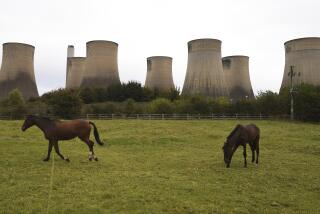Clean Air Act Taking Toll on High-Sulfur Coal Mines, Workers : Pollution: Demand and prices dip as less-harmful grade finds favor. Job outlook is grim.
- Share via
PITTSBURGH — During World War I, bituminous coal production in Pennsylvania, the heart of the nation’s coal industry, peaked at 177 million tons a year. By 1994, that total had plummeted to 58 million.
*
This year, the total is expected to be even lower--even though national demand for coal is rising.
Pollution regulations implemented in January to reduce acid rain-producing sulfur dioxide are cutting into demand for the high-sulfur coal produced in Pennsylvania, northern West Virginia, Ohio, Indiana and Illinois. Low-sulfur coal mined in the West and central Appalachia is picking up the slack.
The new rules mean high-sulfur mines are closing, and mine workers are losing their jobs.
“The market for high-sulfur coal is just disappearing,” said Eileen Goldsmith, a spokeswoman in the United Mine Workers of America’s Washington office. “It’s just geology. There’s really nothing you can do.”
The soft coal mined west of the Mississippi River does not burn as hot as harder coal from the East and Midwest, but it contains less sulfur. That makes Western coal more appealing to utilities trying to comply with requirements of the 1990 Amendments to the Clean Air Act.
Alex Pitrowski, 40, a general laborer at Consolidation Coal Co.’s mine in Arkwright, Pa., must now look for work. His mine shuts this month.
“It’s going to put people out on a job market that looks pretty slim,” said Pitrowski, the secretary-treasurer of UMW Local 5429. “It’s really difficult.”
Ralph Barbaro, a coal-industry analyst with Energy Venture Analysis of Arlington, Va., said, “There’s been a transfer of jobs [to low-sulfur areas], and it’s been a net decline because often the high-sulfur mines had lower productivity” than larger Western mines.
“One person’s loss is another person’s gain. They just don’t gain as much,” he said.
Dan Reitz, a UMW official in Herron, Ill., said, “We’ve tried to figure out a worst-case scenario that the Clean Air Act would cause us, and we’ve already surpassed that.”
He estimated about 1,000 Illinois mining jobs have vanished in each of the past three to four years. He predicted Illinois could lose another 1,000 jobs this year, bringing union membership there to less than 5,000.
Coal production in Pennsylvania dropped 19% over the last year, to 28.5 million tons through Aug. 5, according to federal figures. Wyoming, by contrast, mined 152.8 million tons, 27% more than it produced through Aug. 6 a year ago.
Coal production nationwide rose 1% to 595.5 million tons.
Ted Clutter, an industry analyst and spokesman for the Pennsylvania Coal Assn., questioned the accuracy of the federal statistics, which he pointed out were preliminary. “It just shows us in worse condition than what we’re in,” he said.
But Clutter agreed the Clean Air Act presents a challenge to producers of high-sulfur coal.
The clean-air rules require the 110 power plants that emit the most sulfur dioxide to reduce the emissions to 2 1/2 pounds per million British thermal units of heat generated. Those plants will have to cut their emissions to 1.2 pounds per million starting in 2000.
A warm winter and a cool early summer have made matters worse by reducing the amount of coal that utilities must burn to meet electricity demand.
“It’s a terrible market,” said Bill Spence, owner of Allegheny Valley Resources, a Pittsburgh-based mining company. “The bottom’s falling out. Prices are low.”
Barbaro, the industry analyst, said prices for high-sulfur coal have fallen $2 to a range of $18 to $20 per ton in the past year.
More to Read
Sign up for Essential California
The most important California stories and recommendations in your inbox every morning.
You may occasionally receive promotional content from the Los Angeles Times.










